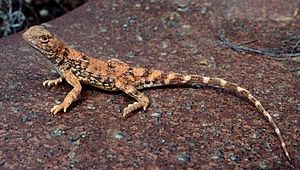Eyrean earless dragon facts for kids
Quick facts for kids Tympancryptis tetraporophora |
|
|---|---|
 |
|
| Scientific classification | |
| Genus: |
Tympanocryptis
|
| Species: |
tetraporophora
|
 |
|
| Distribution Map of Tympanocryptis tetraporophora | |
The Tympanocryptis tetraporophora, also known as the Eyrean earless dragon or long-tailed earless dragon, is a small lizard. It's one of about 15 known species in the Tympanocryptis group. These dragons are special because their "ears" (called a tympanum) are covered with scales. They also have a missing bone in the fifth toe of their back foot.
This dragon lives on the ground in dry and semi-dry areas. You can find it in parts of New South Wales, South Australia, the Northern Territory, and Queensland. It also lives in the tropical grasslands of northern Queensland.
Contents
What's in a Name?
This dragon got its scientific name, Tympanocryptis tetraporophora, because of a special feature. "Tetraporophora" means "four pores." These dragons have four small holes, or pores, on their bodies. Two are near their tail (pre-anal pores), and two are on their thighs (femoral pores).
Appearance and Features
The Eyrean earless dragon is a slim, medium-sized lizard. It has a clear neck and a rounded snout. Its nostrils are closer to its eyes than to the tip of its nose. Its legs are thin and fairly long. The tail gets thinner towards the end and has a rounded tip. As mentioned, it has four pores: two near the tail and one on each thigh.
Their color can change, but they are usually reddish-brown to brown. They often have four to six broken dark stripes across their body. They might also have a faint light stripe on their belly. Their legs and tail usually have dark brown bands. However, older female dragons can lose most of their patterns and look plain.
Where They Live and Their Home
The Eyrean earless dragon lives in a very large area of Australia. This includes South Australia, the Northern Territory, New South Wales, and Queensland. Their homes can be very different. They live in dry areas like stony plains and hills, grasslands, and areas with shrubs. They often hide in cracks in dried-up riverbeds. Their wide range also includes tropical grasslands in northern Queensland.
How They Stay Warm or Cool
These dragons are very clever at controlling their body temperature. They are sometimes compared to tiny meerkats! To warm up, they stand tall on their back legs and tail, facing their back towards the sun. This helps them soak up the heat. If they get too hot, they turn their pale belly towards the sun. This helps them reflect the heat and cool down. This way, they can keep their body temperature just right.
Reproduction and Life Cycle
Eyrean earless dragons lay eggs. This means they are oviparous. They usually breed from early spring to mid-autumn. Female dragons can start having babies when they are about 46 millimeters long from snout to tail vent (SVL). Males are ready to breed when they are about 42 millimeters SVL.
Adult females are usually around 58 millimeters SVL, but can be between 46 and 72 millimeters. A female can lay anywhere from 1 to 14 eggs at a time. Bigger females tend to lay more eggs.
As female dragons get older, especially when they are about 55 millimeters SVL, they often lose their stripes and dark spots. They can become completely plain. Male dragons, however, keep their stripes and spots even when they are fully grown.
See also
 In Spanish: Tympanocryptis tetraporophora para niños
In Spanish: Tympanocryptis tetraporophora para niños

